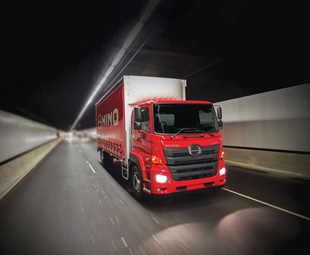Head above water

The waters are not still in the heavy commercial vehicle (HCV) segment … an encouraging notion indeed
Despite tough market conditions and unstable economic and political climates, there’s no denying that vehicle original equipment manufacturers (OEMs) understand the need to invest in both services and products. This has certainly been a year for new vehicle introductions…
So far, in 2017 the HCV segment has seen much movement. There has been the local launch of UD’s Croner, while the all-new Hino 500 will also have made its debut by the time you read this (don’t miss our full local and international launch report in the next issue – ed).
By year end, Eicher – which has just launched its medium-weight contender – will also enter the South African HCV arena with its Pro 6000 Series.
Furthermore, Mercedes-Benz South Africa has ramped up local production of its India-sourced Fuso FA and FJ models, and – amid much controversy and speculation surrounding the withdrawl of General Motors from the local market – Isuzu Motors Limited has affirmed its commitment to incorporating Isuzu Motors South Africa (IMSAf, formerly Isuzu Trucks South Africa) into its business and, therefore, its commitment to the southern African region.
To provide some context, the overall market total for the first six months of 2017 ended at 8 888 units, a decrease of 2,8 percent on the half-year results of 2016.
“Continued busniess reslience in overcoming some of the larger hurdles currently present in the market is contributing to some positive sales results in some of the market segments,” says Gert Swanepoel, managing director of UD Trucks Southern Africa.
How has the HCV segment fared thus far?
According to Itumeleng Segage, senior manager demand planning and pricing at Hino, the HCV market ended the first half of the year some two-percent down (totaling 2 628 units) compared to the first half of 2016 – a statistic he says is in line with the decline in the total commercial vehicle market.
“However, we expect the segment to recover in the second half of the year, ending the year at the same level as 2016,” he adds.
Craig Uren, COO of IMSAf, is just as nonchalant in his prediction: “The industry hit a low of a roughly 11-percent drop in 2016. The gradual growth curve of two to three percent indicates that the industry is just turning itself over. There has been pressure on the HCV segment of the market; in 2016 it dropped 3,6 percent over 2015 levels and is currently less than one percent down on that.”
By the end of 2017, Uren sees the HCV segment finishing on its current level of around 5 800 units.
What are the influencing factors? According to Segage, that answer is a decidedly mixed bag…
“Businesses adopted a ‘wait and see’ approach at the beginning of the year, before they committed to fleet replacements and new purchases. Although the economy is currently in a technical recession, some economic factors have improved. The exchange rate is currently at stable levels and inflation is also comfortably below the Reserve Bank’s target. This means we are under less pressure to have price increases in the second half of the year.
“The recently announced interest rate cut will also bring a welcome relief for consumers. Furthermore, the recovery in the agricultural sector after the drought will have a positive impact,” he adds.
For Uren, supporting the agricultural industry – traditionally important to the HCV segment – as well as small businesses, is more important than ever.
“Although April, May and June have been tough months, in the last six months IMSAF has focused on supporting the agricultural and small-business sectors. The agricultural sector has now improved, and a lot of smaller suppliers to industries like mining have a big impact on our market,” he says. “Customers are buying down to make their applications more cost effective.”
While Uren reckons there is opportunity going forward, he’s also aware of the impact new model introductions can have on the segment. “There have been a lot of new product introductions recently, and the segment is very competitive. This year is definitely one of the most competitive from that perspective,” he says.
Swanepoel is optimistic, too. “Over the last five years the overall market has followed a general downward trend, but the numbers are still good and we are serious about the business,” he says.
The HCV segment as a whole seems to be carrying its weight comfortably at the moment – hopefully a sign of stability to come.
Published by
Focus on Transport
focusmagsa



